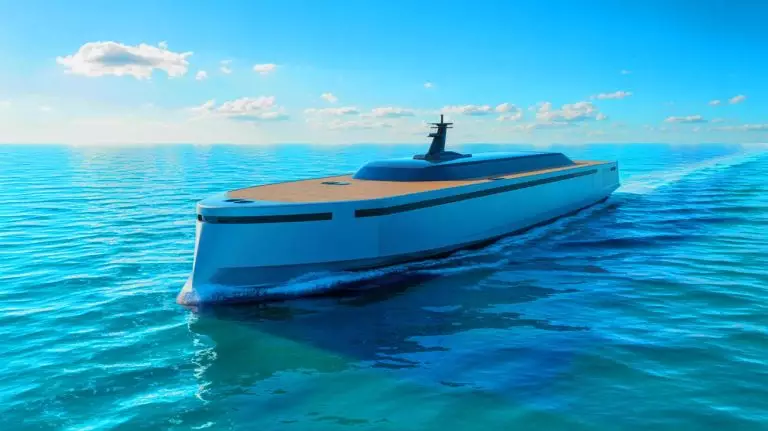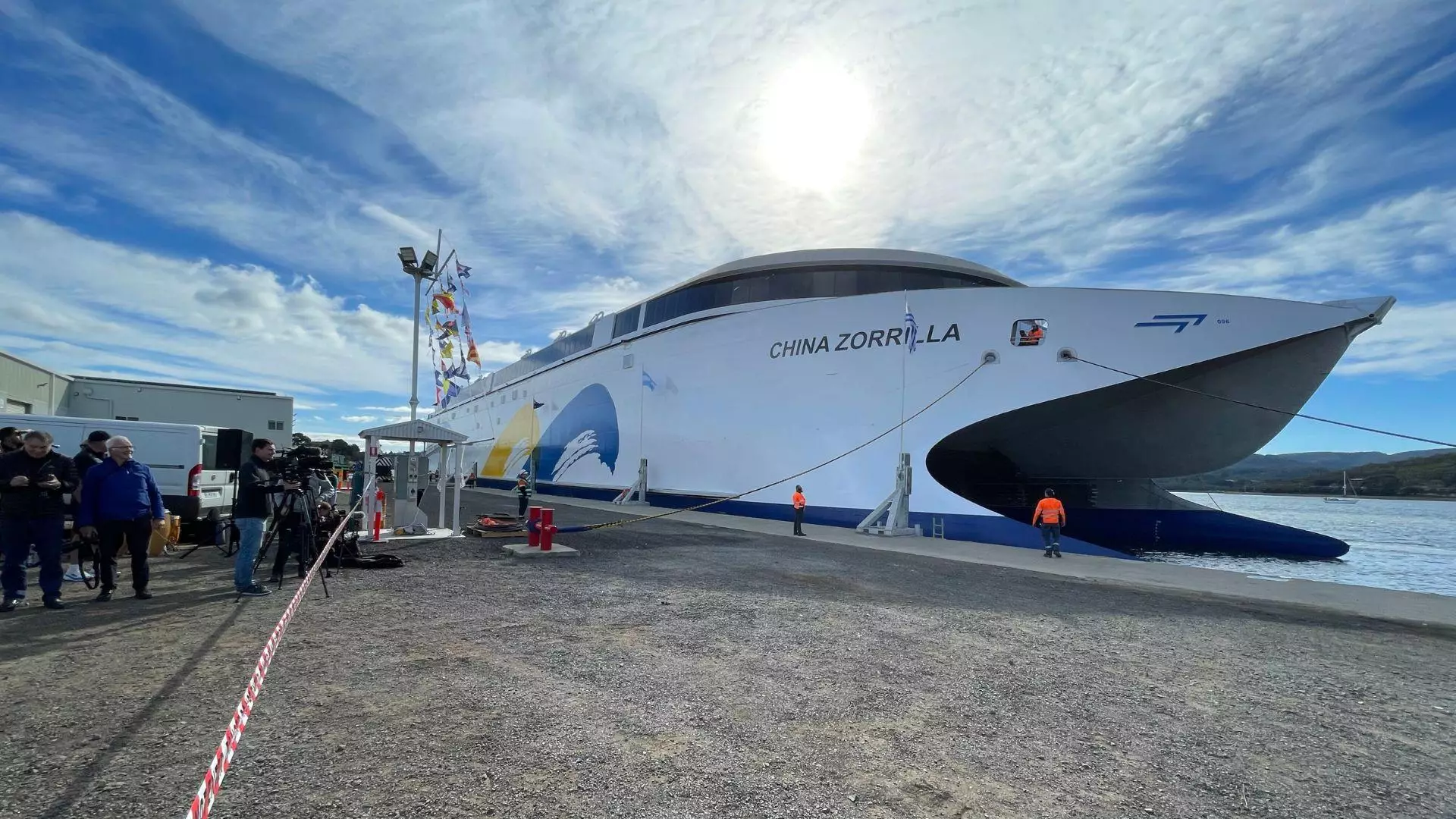| IN A NUTSHELL |
|
In an era where sustainability is increasingly becoming a priority, the launch of the world’s largest battery-powered electric ship marks a pivotal moment for maritime transport. The ship, known as Hull 096, is a 426-foot-long (130-meter) vessel constructed by the renowned shipbuilder Incat. Officially launched in Tasmania, this massive electric vehicle is not only a testament to technological innovation but also a significant step toward reducing emissions in the maritime industry. Named after Uruguayan actress China Zorrilla, the ship will operate between Buenos Aires and Uruguay, signaling a new age of clean energy in ferry transportation.
Fully Electric with Record-Breaking Battery Power
The core of Hull 096’s innovation lies in its massive energy storage system (ESS), which boasts over 275 tons of batteries and more than 40 megawatt-hours of capacity. This makes it the largest battery installation on a ship to date, surpassing previous maritime battery systems by fourfold. The power generated by these batteries drives eight electric water jets, enabling the ship to travel across the Río de la Plata in just 90 minutes. To ensure uninterrupted service, charging stations will be installed on both ends of the route.
Further enhancing its appeal, the ship will feature a 24,757-square-foot (2,300-square-meter) duty-free retail deck, setting a record for the largest shopping area on a ferry. As work continues on its interior, the final battery installations will be completed before the vessel begins its sea trials later this year. These advancements not only highlight the ship’s cutting-edge technology but also underscore Incat’s commitment to pioneering sustainable maritime solutions.
Australia’s Role in Global Maritime Innovation
The launch of Hull 096 has been celebrated as a milestone for both Tasmania and Australia in the realm of zero-emission technology. Tasmanian Premier Jeremy Rockliff hailed the ship as a symbol of the region’s leadership in sustainable innovation. According to Rockliff, Hull 096 sets a new global benchmark for clean maritime transport, showcasing Tasmania’s capacity for producing significant advancements in battery-electric technology.
Incat Chairman Bob Clifford emphasized the importance of this achievement, describing it as the most significant moment in his nearly 70-year career in the marine industry. He stated that the electric ship industry is poised for tremendous growth. Incat CEO Stephen Casey echoed these sentiments, asserting that Hull 096 is not merely a ship but a harbinger of the future. The ship serves as proof that large-scale, low-emission transport solutions are both feasible and ready for implementation.
Dr. Liam Davies from RMIT University noted that the ship’s regular ferry route could serve as a valuable case study for assessing the effectiveness of electric vehicle shipping, further establishing Australia’s role in global maritime innovation.
Partnership with Buquebus: A Commitment to Sustainability
The collaboration between Incat and South American ferry operator Buquebus is a testament to long-term commitments to innovation and sustainability. Hull 096 is the ninth vessel built by Incat for Buquebus, continuing a partnership that has produced several groundbreaking projects over the years. This alliance not only drives technological advancements but also underscores the shared vision of both companies for a cleaner, more sustainable future.
Buquebus has commissioned the ship to operate between Argentina and Uruguay, a route that promises to be emission-free due to the vessel’s battery-electric power. This project is a significant step forward for the ferry operator, aligning with global trends toward reducing carbon footprints in the transportation sector. The ship’s ability to carry up to 2,100 passengers and 225 vehicles purely on battery power is a remarkable achievement, demonstrating a viable path toward sustainable maritime transport.
The Future of Maritime Transport
The introduction of Hull 096 is a landmark event that has set a new standard for the maritime industry. It highlights the potential for electric ships to revolutionize how we think about transportation on water. With its unparalleled battery capacity and innovative design, the ship serves as both a model and a catalyst for future developments in the sector.
As the maritime industry faces growing pressure to reduce emissions, the success of Hull 096 could inspire similar initiatives worldwide. The collaboration between Incat, Buquebus, and other stakeholders demonstrates how partnerships can drive progress and innovation. This project not only benefits the companies involved but also contributes to a broader movement toward sustainable energy solutions. What other groundbreaking innovations will we see as the world continues to embrace sustainable maritime technology?
Did you like it? 4.7/5 (29)








This is amazing! I never thought we’d see a fully electric ship of this size so soon. 🌍
How long does it take to fully charge the ship’s batteries?
Can this be the new Titanic? 😄
Why hasn’t this been done before? Seems like a no-brainer for the environment.
Lazy journalism There are photos of the real thing all over the internet.
It is an amazing ship and development, and I hope to see heaps more of these really soon to replace the filthy fuels that I currently use for boating and shipping.
One word: Impressive!
Does it come with Wi-Fi? 😂
Imagine a world where all ships are electric! This is a fantastic start. 🌊
The ship’s name is after an actress? Interesting choice!
Will this cause a rise in ticket prices for the ferry route?
How does it handle in bad weather? 🚢
Bravo Tasmania for leading the way in zero-emission technology!
Is it just me, or does this sound like something out of a sci-fi movie?
How long can the ship operate on a full charge? ⏳
What happens if there’s a power failure mid-journey?
Do the batteries pose any environmental risks?
Are there any plans for more routes using electric ferries?
I’m skeptical about how reliable it will be in rough seas. Any thoughts?
It’s about time the maritime industry caught up with the electric revolution!
Will passengers notice any difference in the ride compared to traditional ships?
I hope they have a backup plan in case the batteries don’t last.
Congratulations to Incat and Buquebus for this achievement!
What about maintenance costs? Are they higher or lower for an electric ship?
Is the duty-free deck going to be as big as they say? That’s huge! 🛍️
How does the ship compare in speed to diesel-powered ferries?
Wow, this is a game-changer for maritime transport!
Can it operate in different weather conditions without any issues?
It’s incredible to see sustainability and innovation go hand in hand. 🌱
Are there any similar projects underway elsewhere in the world?
This is the future, and it’s here now. Kudos to everyone involved. 🚀
Is the ship quieter than traditional ferries?
Hope this project sets a precedent for others to follow globally!
Where are these giant batteries sourced from? 🌐
What kind of safety measures are in place for the batteries?
Does this mean less pollution in the Río de la Plata? That’s great news!
How often do the batteries need to be replaced?
Can’t wait to see this in action! Any videos available? 🎥
Are there plans to expand this technology to other types of vessels?
How does this compare in terms of emissions to the largest diesel ships?
Thank you for sharing this incredible innovation! It’s inspiring to see progress toward sustainable transport.
This is a great step, but what about the battery disposal issue? 🤔
Could this technology be adapted for cruise ships in the future?